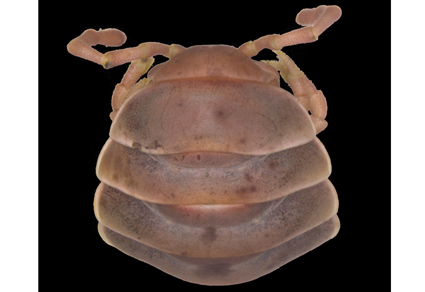Abstract
Three new species of the millipede genus Sandalodesmus Silvestri, 1902 (Diplopoda: Polydesmida: Chelodesmidae) are described from the southeastern coast of Brazil: Sandalodesmus peruibe sp. nov., Sandalodesmus jureia sp. nov., and Sandalodesmus fandango sp. nov. These new species co-occur at the same locality: a protected area within the Atlantic Forest, Estação Ecológica Juréia-Itatins. They are morphologically distinct by the structure of their gonopods. In addition, a revised identification key to all known species of Sandalodesmus is provided.
References
- Bouzan, R.S., Pena-Barbosa, J.P.P. & Brescovit, A.D. (2017) Two new Brazilian species of Chelodesmidae of the genera Iguazus and Tessarithys (Diplopoda: Polydesmida). Zoologia, 34, 1–8. https://doi.org/10.3897/zoologia.34.e19986
- Bouzan, R.S., Iniesta, L.F.M., Pena-Barbosa, J.P.P. & Brescovit, A.D. (2018) Annotated checklist of the millipede family Chelodesmidae Cook, 1895 from São Paulo state, Brazil (Diplopoda: Polydesmida). Papéis Avulsos de Zoologia, 58, e20185806. https://doi.org/10.11606/1807-0205/2018.58.06
- Bouzan, R.S., Iniesta, L.F.M. & Brescovit, A.D. (2019) Cladistic analysis and description of a new species of the Brazilian genus Atlantodesmus Hoffman, 2000 (Diplopoda: Polydesmida: Chelodesmidae). European Journal of Taxonomy, 538, 1–17. https://doi.org/10.5852/ejt.2019.538
- Bouzan, R.S., Means, J.C., Ivanov, K., Pupin, G.B., Brescovit, A.D. & Iniesta, L.F.M. (2023) A case of mass occurrence of Sandalodesmus araujoi (Schubart, 1946) in a municipality of São Paulo, Brazil and description of the heretofore unknown female (Polydesmida, Chelodesmidae). Biota Neotropica, 23 (3), e20231521. https://doi.org/10.1590/1676-0611-BN-2023-1521
- Colombo, A.F. & Joly, C.A. (2010) Brazilian Atlantic Forest lato sensu: The most ancient Brazilian forest, and a biodiversity hotspot, is highly threatened by climate change. Brazilian Journal of Biology, 70 (3), 697–708. https://doi.org/10.1590/S1519-69842010000400002
- Cook, O.F. & Collins, G.N. (1895) The Craspedosomatidae of North America. Annals of the New York Academy of Sciences, 9, 1–100. https://doi.org/10.1111/j.1749-6632.1896.tb55430.x
- Gervais, P. (1844) Aperçu sur la classe des Myriapodes. In: de Blainville, H.M.D. (Ed.), Cours de zoologie, ou de l’histoire naturelle des animaux. Règne animal, Mollusques, Annélides et Myriapodes. P. Bertrand, Paris, pp. 776–795. Available from: http://biodiversitylibrary.org/page/2272843 (accessed 28 January 2025)
- Hijmans, R.J., Cruz, M., Rojas, E. & Guarino, L. (2001) DIVA-GIS, Version 1.4. A Geographic Information System for the Management and Analysis of Genetic Resources Data. Manual. International Potato Center, Lima. [program]
- Hoffman, R.L. (1967) Chelodesmid studies III. Notes on the status of Gonioleptodesmus, the description of a new species from Minas Gerais, and a key to the presently known members of the genus (Diplopoda, Polydesmida). Papéis Avulsos do Departamento de Zoologia, 21 (4), 33–42. Available from: https://www.revistas.usp.br/paz/article/download/209549/192282 (accessed 25 January 2025) https://doi.org/10.11606/0031-1049.1967.21.p33-42
- Hoffman, R.L. (1980) Classification of the Diplopoda. Muséum d’Histoire Naturelle, Genève, 237 pp.
- Hoffman, R.L. (1982) Chelodesmid studies. XVIII. A synopsis of the genus Sandalodesmus Silvestri, 1902, and proposal of the new tribe Sandalodesmini (Polydesmida: Chelodesmidae). Spixiana, 5 (3), 247–259. Available from: https://www.biodiversitylibrary.org/page/28194567 (accessed 28 January 2025)
- Pena-Barbosa, J.P.P., Sierwald, P. & Brescovit, A.D. (2013) On the largest chelodesmid millipedes: taxonomic review and cladistic analysis of the genus Odontopeltis Pocock, 1894 (Diplopoda; Polydesmida; Diplopoda). Zoological Journal of the Linnean Society, 169 (4), 737–764. https://doi.org/10.1111/zoj12086
- Pocock, R.I. (1887) On the classification of the Diplopoda. Annals and Magazine of Natural History, Series 5, 20 (118), 283–295. Available from: https://www.biodiversitylibrary.org/part/68552 (accessed 28 January 2025) https://doi.org/10.1080/00222938709460057
- Rezende, C.L., Scarano, F.R., Assad, E.D., Joly, C.A., Metzger, J.P., Strassburg, B.B.N., Tabarelli, M., Fonseca, G.A. & Mittermeier, R.A. (2018) From hotspot to hopespot: An opportunity for the Brazilian Atlantic Forest. Perspectives in Ecology and Conservation, 16 (4), 208–214. https://doi.org/10.1016/j.pecon.2018.10.002
- Rojas-Buffet, C., Bouzan, R.S., Sierwald, P., Brescovit, A.D. & Simó, M. (2022) Sandalodesmus joachimadisi n. sp., the first Chelodesmidae member from Uruguay with an updated key to species of the genus (Diplopoda: Polydesmida). Zootaxa, 5150 (2), 260–268. https://doi.org/10.11646/zootaxa.5150.2.5
- Schubart, O. (1944) Os diplopodos de Pirassununga. Acta Zoologica Lilloana, 2, 321–440.
- Schubart, O. (1946) Contribuição ao conhecimento do gênero Leptodesmus (Família Leptodesmidae, Diplopoda). Anais da Academia Brasileira de Ciências, 18, 165–202.
- Schubart, O. (1954a) Sobre os Diplopoda dos estados do Paraná e Santa Catarina. I. Proterospermophora. Arquivos do Museu Paranaense, 10, 77–132.
- Schubart, O. (1954b) Diplópodos argentinos del Museo de la Ciudad Eva Perón. I. Familia Leptodesmidae. Notas del Museo, 17, 113–146.
- Schubart, O. (1956) “Leptodesmidae” brasileiras III. Espécies de Minas Gerais (Diplopoda, Proterospermophora). Revista Brasileira de Biologia, 16, 355–367.
- Schubart, O. (1958) “Leptodesmidae” brasileiras VI. Espécies novas do estado do Rio Grande do Sul (Diplopoda, Proterospermophora). Revista Brasileira de Biologia, 18, 23–32.
- Shelley, R.M. & Smith, J.M. (2018) Expanded concept and revised taxonomy of the milliped family Xystodesmidae Cook, 1895 (Polydesmida: Leptodesmidea: Xystodesmoidea): Incorporations of Euryuridae Pocock, 1909 and Eurymerodesmidae Causey, 1951, taxon revivals/proposals/transferrals, and a distributional update. Insecta Mundi, 0660, 1–41. Available from: https://zenodo.org/records/3709976 (accessed 28 January 2025)
- Sierwald, P., Decker, P. & Spelda, J. (2025) MilliBase. Available from: https://www.millibase.org/aphia.php?p=search (accessed 10 May 2025)
- Silvestri, F. (1895) Viaggio del dottor Alfredo Borelli nella Repubblica Argentina e nel Paraguay XIV. Bollettino Musei di Zoologia ed Anatomia Comparata, 10, 1–12. Available from: https://www.biodiversitylibrary.org/page/43066189 (accessed 28 January 2025) https://doi.org/10.5962/bhl.part.8048
- Silvestri, F. (1902) Viaggio del Dr. A. Borelli nel Matto Grosso. VII. Diplopodi. Bollettino dei Musei di Zoologia ed Anatomia Comparata della R. Università di Torino, 17, 1–25. Available from: https://www.biodiversitylibrary.org/page/11675026 (accessed 28 January 2025) https://doi.org/10.5962/bhl.part.26628


